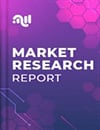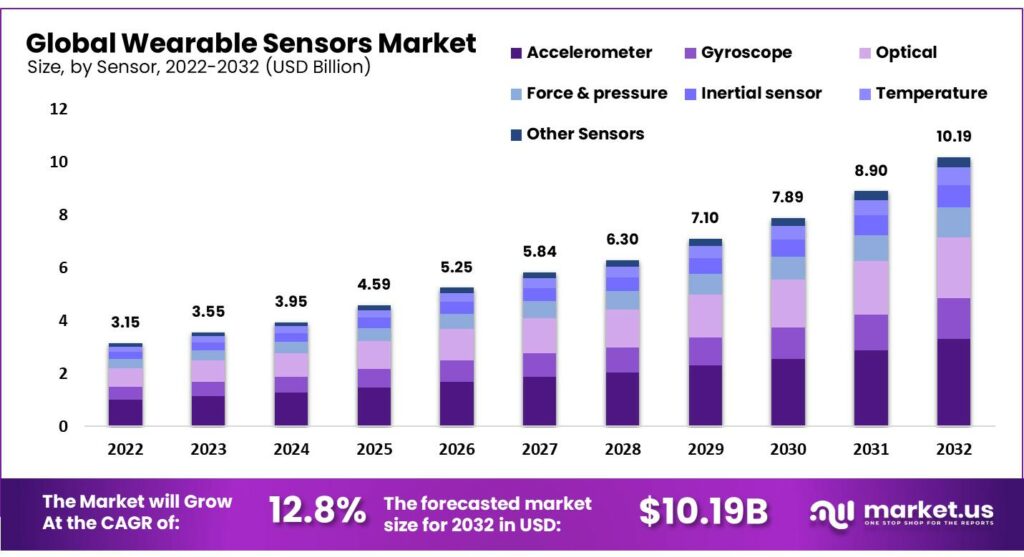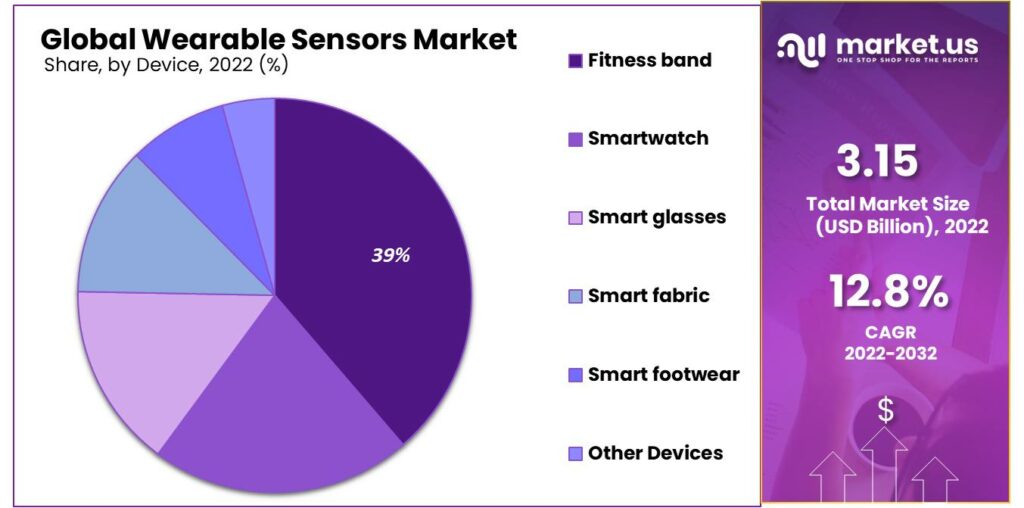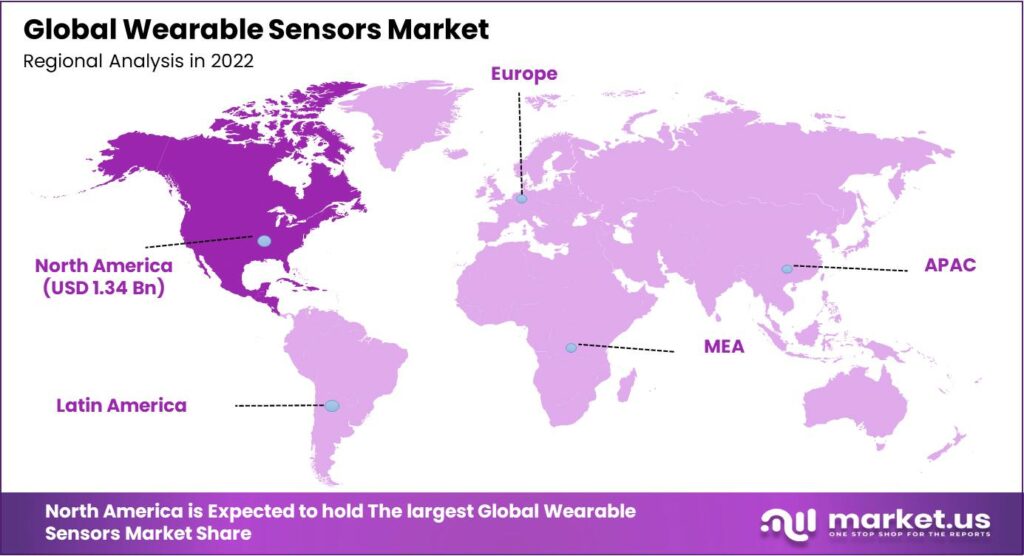Global Wearable Sensors Market By Sensor (Accelerometer, Gyroscope, Optical, Force & pressure, Inertial sensor, Temperature, and Other Sensors), By Device (Smartwatch, Fitness band, Smart glasses, Smart fabric, Smart footwear, and Other Devices), By Vertical (Consumer, Defense, Healthcare, Industrial, and Other Vertices), By Region and Companies - Industry Segment Outlook, Market Assessment, Competition Scenario, Trends, and Forecast 2023-2032
- Published date: Apr. 2024
- Report ID: 27749
- Number of Pages: 359
- Format:
- keyboard_arrow_up
Quick Navigation
Report Overview
The Global Wearable Sensors market size is expected to be worth around USD 10.19 Billion by 2032, from USD 3.55 Billion in 2023, growing at a CAGR of 12.8% during the forecast period from 2024 to 2033.
The wearable sensor market is for wearables equipped with sensors to track health and fitness parameters. They also include blood pressure sensors & glucose sensors. These sensors allow for the collection of real-time data on health & fitness metrics which can be used by consumers & healthcare professionals for monitoring & analyzing the well-being of an individual.
The wearable sensor market is driven by the increasing awareness of health & fitness in consumers, the prevalence of chronic disease, and advances in sensor technology and artificial intelligence. The increasing adoption of remote monitoring solutions in the healthcare industry is also expected to fuel the demand for wearable sensor devices. The market is highly competitive with major players like Apple, Fitbit, and Samsung Electronics, among others.

Key Takeaways
- The global Wearable Sensors market is expected to reach USD 10.19 billion by 2033, with a steady Compound Annual Growth Rate (CAGR) of 12.8% between 2023 and 2032.
- Accelerometers dominate the market with a 32.4% market share and a CAGR of 12.7%.
- Optical sensors are expected to experience rapid growth with a CAGR of 13.4%.
- Fitness bands accounted for the largest revenue share in 2022 (38.7%).
- Smartwatches are projected to be the fastest-growing segment with a CAGR of 14.4%.
- The consumer segment holds the significant share in the wearable sensors market (44.5%) and fastest-growing with a CAGR of 13.7%.
- North America accounted for the largest revenue share in 2022 (42.7%).
- Asia-Pacific is expected to be the fastest-growing region with a CAGR of 13.8%.
By Sensor Analysis
The Accelerometer Segment Holds the Significant Share in Wearable Sensors Market.
Based on sensors, the wearable sensors market is attributed to accelerometers, gyroscopes, optical, force & pressure, inertial sensors, temperature, and other sensors. Among these types, the accelerometer segment dominates in the global wearable sensors market, with a market share of 32.4% & CAGR of 12.7%.
Owing to fitness tracking applications, accelerometers & gyroscopes are used to measure motion & orientation, while optical sensors are used for measuring heart rate & blood oxygen levels. Furthermore, in medical applications, temperature sensors are used to monitor body temperature and inertial sensors are used to monitor movement & position.
Optical Segment Are Expected to Fastest Grow in Wearable Sensors Market in Forecasted Period.
Optical sensors experienced rapid growth in recent years with a CAGR of 13.4%, owing to wearable devices having grown in popularity due to the application of optical sensors. They are integrated into smart wearables & play a crucial role in providing precise electrocardiograms (EKGs) with the highest accuracy. In addition, it allows for highly sensitive measurements of health parameters and the surrounding environment, which is expected to boost demand over the forecast period.
By Device Analysis
The Fitness Band Segment Accounted for the Largest Revenue Share in 2022.
Based on devices, the market is divided into smartwatches, fitness bands, smart glasses, smart fabric, smart footwear, and other devices. Among these types, the fitness band segment is expected to dominate the global wearable sensors market, with a market share of 38.7% & projected CAGR of 12.6% during the forecast period. The popularity of fitness & health devices is increasing among consumers.
New players on the market offer advanced fitness band technology for prices lower than smartwatches. This will be the major factor in driving the segment’s growth. In addition, fitness bands are credited with launching new models, increasing the user base, and providing dynamic analyses of user activities, such as tracking steps, heart rate variations, calorie count, and sleep analysis.
The Smartwatch Segment is Expected to be the Fastest Growing Segment.
The smartwatch segment is expected to be the fastest-growing device segment in the forecasted period, with a CAGR of 14.4%. Smartwatches offer a range of features that can enhance productivity & convenience, like notifications, phone calls & messaging. Additionally, smartwatches are provided with various sensors like gyroscopes, accelerometers, and heart rate sensors that can track various health & fitness specifications, which makes them attractive to consumers who give importance to health & fitness.

By Vertical Analysis
The Consumer Segment Holds the Significant Share of the Application Segment in the Wearable Sensors Market.
Based on vertical, the market for wearable sensors is divided into consumer, defense, healthcare, industrial, and other vertices. Among these types, the consumer segment is expected to be dominant in the global wearable sensors market, with a market share of 44.5% and a CAGR of 13.7%. Owing to sensor fused devices are becoming more popular as users are becoming more aware of remote monitoring for wellness & fitness.
The demand for wearables is driven by several factors, like technological advancements in sensors, the availability of wearables, and the ability of sellers to differentiate their products. Over the forecast period, wearables will continue to be the most popular product. The recent increase in wearables is due to an increased demand for fitness, lifestyle, and wellness tracking devices.
Consumer Segment is Also Expected to Fastest Grow in Wearable Sensors Market in Forecasted Period.
The consumer segment is experiencing rapid growth in recent years with a CAGR of 13.7% because the market is growing rapidly with the popularity of wrist-worn VR headsets and smart clothing. Vendors are looking towards providing users with the best solutions. This segment will also grow rapidly as consumers’ spending power increases, specifically on electronics. Wearables are being developed by larger companies that combine fashion & utility. The growth of this consumer segment will also be driven by constant innovation.
Key Market Segments
Based on Sensor
- Accelerometer
- Gyroscope
- Optical
- Force & pressure
- Inertial sensor
- Temperature
- Other Sensors
Based on Device
- Smartwatch
- Fitness band
- Smart glasses
- Smart fabric
- Smart footwear
- Other Devices
Based on Vertical
- Consumer
- Defense
- Healthcare
- Industrial
- Other Verticals
Driving Factors
The rising Prevalence of Chronic Diseases and Advances in Sensor Technology is Expected to Drive the Market Growth
The wearable sensors market is expected to witness significant growth in the coming years due to several drivers. Firstly, the increasing prevalence of chronic diseases like diabetes & cardiovascular diseases is expected to drive the demand for wearable sensors that can monitor & manage these conditions. Wearable sensors offer a noninvasive & continuous method of monitoring health parameters which can improve the quality of care for patients & reduce healthcare costs.
Second, there is increasing awareness of health & fitness among consumers, leading to increased demand for wearable sensors that track various health parameters. Wearable sensors provide users with real-time responses on their health and fitness, which helps them to make informed decisions about their well-being. Thirdly, advances in sensor technology, artificial intelligence, and machine learning enable the development of more accurate & personalized wearable sensors that cater to the specific needs of consumers.
Wearable sensors can now track a wide range of health parameters with high accuracy, enabling more precise diagnosis and treatment. Fourthly, the growing adoption of remote patient monitoring solutions is expected to further fuel the demand for wearable sensors in the healthcare sector. Wearable sensors are being increasingly used in telehealth applications, allowing healthcare professionals to monitor patients remotely and provide timely interventions when needed.
Restraining Factors
High Costs and Limited Battery Life Can Hamper the Growth of the Market
The wearable sensors market faces several restraints that may hinder growth in the coming years. The high cost of wearable sensors and associated technologies is a significant restraint for the market, particularly in developing economies where affordability is a key factor in adoption. Limited battery life is a major challenge for many wearable sensors as it may hamper their usability & limit their effectiveness in real-world applications.
Concerns over data privacy and security are also a restraint, as the collection and storage of personal data by wearable sensors raise concerns over privacy and security, particularly in the healthcare sector. Limited interoperability and the lack of standardization in the wearable sensors market may lead to interoperability issues and hinder the development of innovative products and technologies. Finally, design and usability challenges, such as being uncomfortable to wear or difficult to use, may limit the adoption and effectiveness of wearable sensors.
Growth Opportunity
Increased Adoption of Wearable Technologies for Various Applications Creates Opportunities in the market
Wearable sensors are expected to grow rapidly in the following years, and this is due to several factors. Wearable sensors are expected to get in high demand due to the rising adoption of wearable technologies for various applications like healthcare, fitness, and sports. The increasing awareness of fitness & health among consumers drives the demand for wearable sensor devices that track health parameters like blood pressure, heart rate, and glucose levels.
The increasing prevalence of chronic illnesses like diabetes & cardiovascular diseases will also drive the demand for wearable sensor devices that can monitor these conditions. Wearable sensors integrated with AI & ML technology are expected to offer more accurate & personalized insight to users, leading to an increase in adoption. The development of flexible sensors & advanced materials is expected to result in more comfortable wearable devices.
The increasing investment in research and development by both private & public organizations will lead to the development of innovative products & technologies, which will create further growth opportunities for wearable sensors. These factors will drive the growth of wearable sensors in the future.
Latest Trends
Integration of Advanced Sensors with Artificial Intelligence and Machine Learning Technologies is Trending in the Market
The wearable sensors market constantly evolves, introducing new and innovative products regularly. Some of the latest trends in the wearable sensors market include the integration of advanced sensors with artificial intelligence & machine learning technologies. This allows for collecting and analyzing large amounts of data, leading to improved accuracy & personalized insights for users.
Another trend is the increased use of wearable sensors in the healthcare sector, specifically in the areas of remote patient monitoring & disease management. Wearable sensors are being used to track a wide range of health parameters like heart rate, glucose levels, blood pressure, and respiratory rate, enabling healthcare professionals to monitor patients remotely & provide timely interventions when needed.
Furthermore, combining wearable sensors with virtual reality & augmented reality technologies is also gaining popularity, allowing for more immersive and interactive experiences. Finally, there is a rising focus on developing flexible and stretchable sensors that can conform to the body, allowing for more comfortable & natural use. Overall, these trends are expected to shape the future of the wearable sensors market, focusing on improving the usability, accuracy, and personalization of wearable devices.
Regional Analysis
North America Accounted for the Largest Revenue Share in Wearable Sensors Market in 2022.
North America is the dominant region in the global wearable sensors market. North America is expected to have the highest revenue share, 42.7%. North America should also register a CAGR of 13.2% over the forecast period. Owing to the region has a high adoption rate of advanced technologies and a large number of tech-savvy consumers, which has driven the demand for wearable sensors.
Secondly, the region has a well-established healthcare infrastructure, which has increased the use of wearable sensors in healthcare applications like remote patient monitoring & disease management. Additionally, the presence of major players in the region, like Apple & Fitbit, has led to the development of innovative wearable sensor products that cater to the needs of consumers.
Asia-Pacific is Expected as Fastest Growing Region in Projected Period in Wearable Sensors Market.
APAC is expected to be as fastest growing region in the forecast period in the wearable sensors market, with a CAGR of 13.8%. The region has a large population with increasing disposable income, leading to a rise in consumer spending on technology & healthcare. This resulted in rising demand for wearable sensors in this region, specifically in countries like India, China, and Japan.
The region has a growing aging population & an increasing prevalence of chronic diseases, which leads to the rise in demand for remote patient monitoring & disease management solutions. As a result, wearable sensors are being increasingly used in these applications, leading to their growing adoption in the region.

Key Regions and Countries Covered in this Report:
- North America
- The US
- Canada
- Europe
- Germany
- France
- The UK
- Spain
- Italy
- Russia
- Netherland
- Rest of Europe
- APAC
- China
- Japan
- South Korea
- India
- Australia
- New Zealand
- Singapore
- Thailand
- Vietnam
- Rest of APAC
- Latin America
- Brazil
- Mexico
- Rest of Latin America
- Middle East and Africa
- South Africa
- Saudi Arabia
- UAE
- Rest of MEA
Key Players Analysis
The wearable sensors market is highly competitive & comprises various major players operating globally. These players mainly focused on product innovation, research & development, strategic partnerships & collaborations, and mergers & acquisitions to strengthen their market position.
Companies produce a range of wearable devices like fitness trackers, smartwatches, and other wearable sensors which are provided with different sensors to track health & fitness metrics. With the rising demand for wearable technology and the increasing awareness of health & fitness, these players are expected to continue investing in research & development to offer innovative and advanced products for meeting the changing needs of consumers.
Market Key Players
- Robert Bosch GmbH
- STMicroelectronics N.V.
- Texas Instruments Incorporated
- Infineon Technologies AG
- Analog Devices Inc.
- InvenSense Inc. (TDK Corporation)
- Infineon Technologies AG
- InvenSense Inc.
- Other Key Players
Recent Developments
- STMicroelectronics (Switzerland) made a significant announcement in May 2023, launching its initial MEMS pressure sensors known for high accuracy and superior environmental robustness. These sensors are particularly applicable in gas and water-metering equipment, weather monitoring, air conditioning, and home appliances.
- In April 2023, Knowles Electronics (US) introduced the Trio of Sisonic MEMS microphones, specifically crafted for ear and wearable solutions. The cutting-edge SiSonic microphones contribute to enhancing the audio experience, aligning with the dynamic requirements of the contemporary on-the-go lifestyle.
Report Scope
Report Features Description Market Value (2023) US$ 3.55 Bn Forecast Revenue (2032) US$ 10.19 Bn CAGR (2023-2032) 12.8% Base Year for Estimation 2022 Historic Period 2016-2022 Forecast Period 2023-2032 Report Coverage Revenue Forecast, Market Dynamics, COVID-19 Impact, Competitive Landscape, Recent Developments Segments Covered By Sensor (Accelerometer, Gyroscope, Optical, Force & pressure, Inertial sensor, Temperature, Other Sensors), By Device (Smartwatch, Fitness band, Smart glasses, Smart fabric, Smart footwear, Other Devices), By Vertical (Consumer, Defence, Healthcare, Industrial, Other Vertices) Regional Analysis North America – The U.S. & Canada; Europe – Germany, France, The UK, Spain, Italy, Russia, Netherlands & Rest of Europe; APAC- China, Japan, South Korea, India, Australia, New Zealand, Singapore, Thailand, Vietnam & Rest of APAC; Latin America- Brazil, Mexico & Rest of Latin America; Middle East & Africa- South Africa, Saudi Arabia, UAE & Rest of MEA Competitive Landscape Robert Bosch GmbH, STMicroelectronics N.V., Texas Instruments Incorporated, Infineon Technologies AG, Analog Devices Inc., InvenSense Inc. (TDK Corporation), Infineon Technologies AG, InvenSense Inc., Other Key Players Customization Scope Customization for segments, region/country-level will be provided. Moreover, additional customization can be done based on the requirements. Purchase Options We have three licenses to opt for Single User License, Multi-User License (Up to 5 Users), Corporate Use License (Unlimited User and Printable PDF) Frequently Asked Questions (FAQ)
What are wearable sensors?Wearable sensors are small, lightweight devices that can be integrated into clothing, accessories, or directly worn on the body. These sensors are designed to monitor and track various physiological parameters, such as heart rate, body temperature, movement, and activity levels, providing valuable health and fitness data to users and healthcare professionals.
What are the key applications of wearable sensors?Wearable sensors find applications in various sectors, including healthcare, sports and fitness, consumer electronics, and industrial applications. They are used for purposes such as remote patient monitoring, activity tracking, gesture recognition, fall detection, and environmental sensing, among others.
How do wearable sensors contribute to the healthcare industry?Wearable sensors play a crucial role in the healthcare industry by enabling continuous monitoring of vital signs, facilitating early detection of health issues, supporting remote patient care, and promoting proactive health management through personalized and data-driven insights.
What are some challenges associated with the adoption of wearable sensors?Some common challenges associated with the adoption of wearable sensors include data accuracy and reliability, data privacy and security concerns, user comfort and acceptance, sensor calibration and maintenance, and the need for interoperability with existing healthcare systems and data analytics platforms.
What are the current trends in the wearable sensors market?The wearable sensors market is witnessing several notable trends, including the development of miniaturized and energy-efficient sensor technologies, the integration of advanced biometric and environmental sensors, the convergence of wearable sensors with AI and data analytics, and the emergence of smart textiles and e-textiles with built-in sensor capabilities.

- Robert Bosch GmbH
- STMicroelectronics N.V.
- Texas Instruments Incorporated
- Infineon Technologies AG
- Analog Devices Inc.
- InvenSense Inc. (TDK Corporation)
- InvenSense Inc.
- Other Key Players
- settingsSettings
Our Clients
| Single User $4,599 $3,499 USD / per unit save 24% | Multi User $5,999 $4,299 USD / per unit save 28% | Corporate User $7,299 $4,999 USD / per unit save 32% | |
|---|---|---|---|
| e-Access | |||
| Report Library Access | |||
| Data Set (Excel) | |||
| Company Profile Library Access | |||
| Interactive Dashboard | |||
| Free Custumization | No | up to 10 hrs work | up to 30 hrs work |
| Accessibility | 1 User | 2-5 User | Unlimited |
| Analyst Support | up to 20 hrs | up to 40 hrs | up to 50 hrs |
| Benefit | Up to 20% off on next purchase | Up to 25% off on next purchase | Up to 30% off on next purchase |
| Buy Now ($ 3,499) | Buy Now ($ 4,299) | Buy Now ($ 4,999) |












